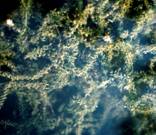|
"Your gateway to
understanding |
Elodea

- Common, native plant in Oneida Lake
- Can survive rooted in the lake bottom, or floating on the water’s surface
- Creates hiding places that are important for fish and amphibians
Elodea is native to Oneida Lake, and is commonly found throughout North America as an aquarium plant. It lives entirely underwater with the exception of its small white or pale purple flowers. These flowers are attached to the plant by delicate stalks, and bloom at the water’s surface. Elodea’s bright green leaves form in whorls (circular arrangements) around the stem, with three or occasionally four leaves per whorl. Female plants produce egg-shaped capsules about ¼ inch long that contain several seeds. Seeds will ripen underwater and are tapered, round, and narrowly cylindrical.
Elodea grows best in silty sediments, but is found rooted in a variety of sediment types. It likes lakes with nutrient rich water, and will grow everywhere from very shallow to deep water. After being uprooted, Elodea can even survive as floating fragments. In the fall, leafy stalks will detach from the parent plant, float away, root, and start new plants. This is Elodea’s most important method of spreading, with seed production playing a relatively minor role.
Elodea is common in Oneida Lake. It provides good habitat for aquatic invertebrates, fish, and amphibians, and it is a major food source for ducks, geese, beaver and muskrat. Historically, Elodea was even used as a medicinal drug by the Iroquois.
To learn more about Elodea...
